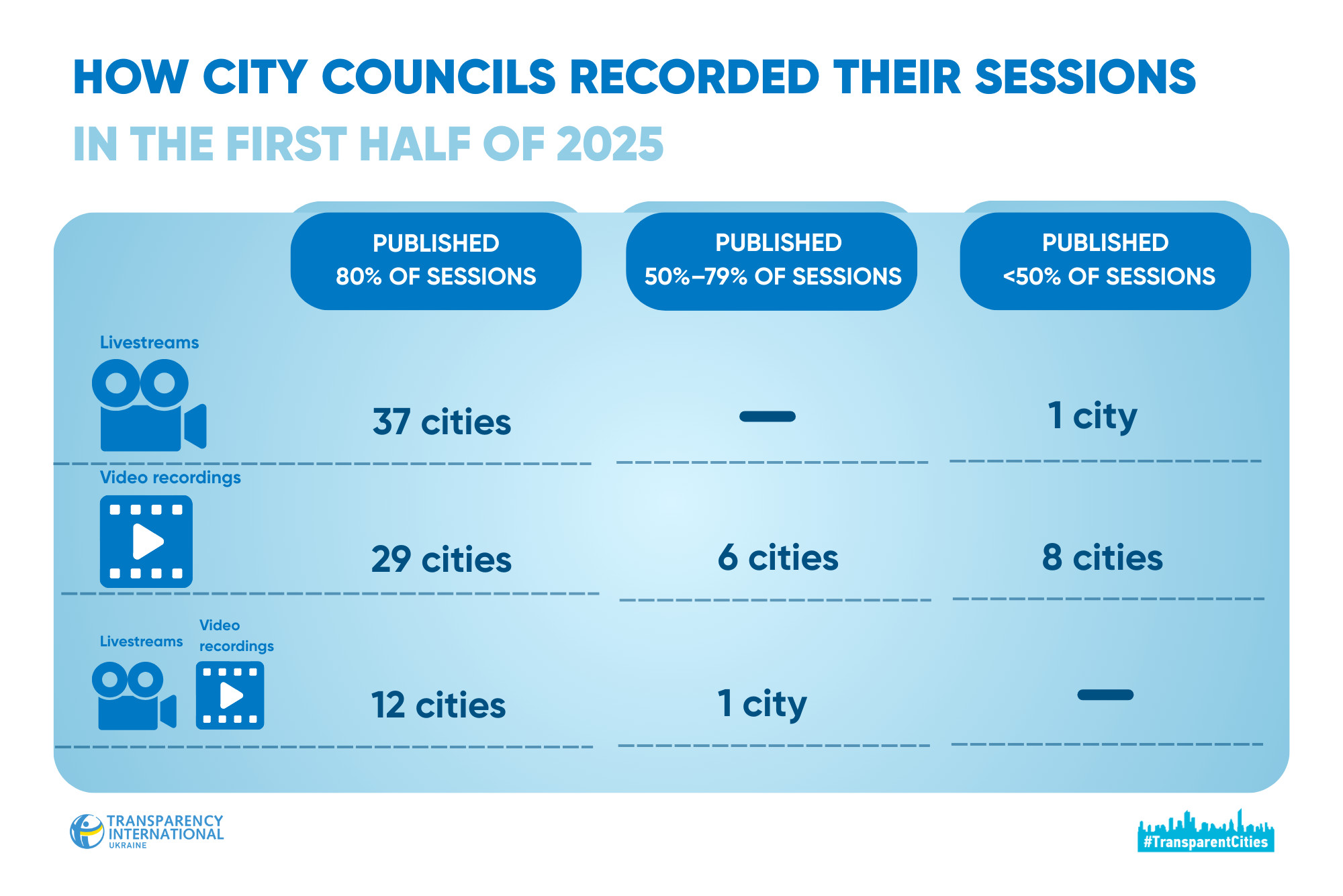The Transparent Cities program examined whether municipalities have been livestreaming council sessions and publishing video recordings as required by law. As of January 1, 2025, 23 out of 100 cities had not published any videos of their sessions. Within the following six months, that number decreased to six. However, nine cities still published recordings of less than half of their council sessions.
On August 15, 2024, updated provisions of the Law of Ukraine on Local Self-Government entered into force, requiring city councils to record their sessions and publish the recordings no later than the day after the meeting. The law also stipulates that once martial law in Ukraine is lifted, all sessions must be broadcast in real time.
Analysts assessed how cities complied with these new legal requirements during 2024 and the first half of 2025, in particular whether they conducted online broadcasts, preserved the recordings, and published them no later than the day after the session.
The findings showed that last year, 57 out of 100 cities published 80% or more of their council session videos or livestreams. Another 20 municipalities published records of 50%–79% of sessions, mostly starting in the second half of the year — after the new law took effect. At the same time, as of January 1, 2025, 23 cities still ignored their obligation to publish session recordings. Among them was the regional center Sumy, which had published videos of less than half of its 2024 sessions. In 2025, however, the Sumy City Council published videos of all its sessions.
By mid-August 2025, the situation had improved significantly: 78 out of 1001 city councils published more than 80% of their session videos or livestreams. Seven municipalities published 50%–79% of sessions.Unfortunately, Vyshneve, Horishni Plavni, Konotop, Kryvyi Rih, Mohyliv-Podilskyi, and Fastiv did not publish any videos, while nine other cities published less than half.2 More than half of the recordings in Berehove, Zhmerynka, Zolochiv, Izmail, Kostopil, Pryluky, Sambir, Shakhtarsk, and Shostka were posted with delays beyond the legal deadline.
Among the 20 regional centers reviewed, only one failed to fully comply with the requirement for timely video recording. In Ivano-Frankivsk, some session videos were published later than the next day. Most regional centers, however, livestream their sessions in real time — 12 municipalities have adopted this practice, while three combine livestreaming with later uploads. Three regional centers located in areas of potential hostilities (Zaporizhzhia, Sumy, and Kharkiv) publish only recorded videos. By contrast, Mykolaiv, also in such an area, livestreams all council sessions, which currently take place online.
Cities that ranked highest in the 2024 Transparency Ranking — Vinnytsia, Lutsk, Lviv, Mukachevo, and Chernivtsi — broadcast every council session in 2025. Meanwhile, among the 22 “partially transparent” cities, 21 published more than 80% of their session videos or livestreams.

Cities have organized livestreaming and video publication in different ways. Thirty-eight city councils ensured real-time broadcasts (37 of them did so for all 2025 sessions). Forty-three municipalities follow the “simplified” approach of posting video recordings instead of livestreams; among them, 29 consistently comply with the statutory deadlines. Thirteen cities alternate between formats — sometimes livestreaming, other times posting recorded videos.
Municipalities also use different platforms to share videos. Most rely on YouTube — 94 councils maintain active accounts there. Three municipalities also use Facebook for livestreaming. Some adopt less common practices: in Pokrov and Chernihiv, session videos are published as individual mp4 files on the council’s website. In Hlukhiv, Marhanets, Shostka, and several other cities, recordings are available on YouTube only via direct links from the official website, limiting accessibility for broader audiences.
A good practice is creating a dedicated webpage on the official city website with all links to livestreams and recordings. Half of the reviewed municipalities have already introduced such a solution. Implementation formats vary: some localities provide a simple list of links, others embed videos directly for viewing, while still others integrate links near session minutes or decisions, often as a separate column or “View Video” button. In some cases, videos are published in the news section alongside text summaries of sessions. The most user-friendly approaches organize videos by session dates and numbers.
The first half of 2025 shows noticeable progress in video recording and broadcasting of city council sessions. Transparent Cities calls on municipalities to continue improving their practices — refining formats, making access more convenient, and thereby giving residents a genuine opportunity to influence the governance of their city.
Earlier, the program also reviewed whether citizens could physically attend council sessions and whether access rules were clearly defined. It found that only 10 out of 100 municipalities had formulated clear procedures for public access.
1. The sample included the 100 largest cities in Ukraine, according to data from a mobile operator, with the exception of Ternopil, which was excluded from the study due to documented cases of data falsification on the city council’s official website.
2. The list of published recordings for 2025 is cross-checked against the list of council session minutes, or, where minutes are unavailable, against the mayor’s orders convening the sessions.